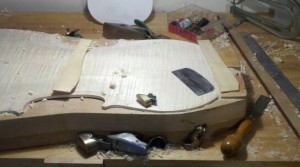Refining an arching seems like such a simple thing, using templates as guides to blend the curves into an organic whole. But is tougher than it seems. Like playing in tune, there are a multitude of ways to fail, and only one way get it right. I believe arching is one of the three keys to great tone and consequently give a great deal of attention to do it as well as I possibly can.

Visitors who see this process often kid me about the wax on – wax off scene from The Karate Kid, but they are not far from the truth. Finding that one right shape takes thousands and thousands of cuts with progressively finer tools; chunks with gouges, then shavings with small planes, finally using scrapers to a finish. It takes many hours of work, and part of the process is pausing to rest and check it over with fresh eyes before moving on to the next step. The time passes quickly though, and I find myself in a meditative trance about how I hope to sculpt the sound of this piece of wood.
No two pieces of wood are alike, even out of the same tree, and the art of this task is to feel the wood under the thousands of cuts and understand what kind of sound will best work with the nature of this piece of wood. The backs are of maple, and some pieces of maple are like granite, or ice, or hard rubber, or hard cheese, or Bakelite. Sometimes the wood feels stringy like a carrot, grainy like sandy soil, as crisp and tender as an apple or silky and smooth. The wood speaks and I try to listen, and the most successful instruments invariably seem to be the ones that give me a great deal of difficulty before I find a satisfactory solution. This, I believe is a pretty widespread phenomenon in the arts, and one of the more annoying aspects of the life.
One Response to Refining an arching is like playing in tune.